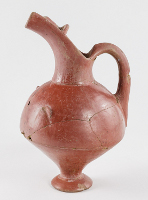Anatolia - the Asiatic portion of modern Turkey - is represented in the museum primarily by artifacts from Oriental Institute excavations in the early 1930's at the site of Alishar Hüyük. These objects illustrate particularly well the material culture of that single region and document in detail its development.
Pitcher with built-in strainer
This gracefully shaped pitcher was a mortuary gift in a communal burial chamber. The highly polished exterior has a brown-red slip and shows striations of the polishing stone. Two breast-like protuberances placed on the upper body of the vessel lend it a slight anthropomorphic air. The elegant spout curves upward from the neck and is supplied with a strainer to remove impurities from the liquid that was poured through it.
Pair of Bull Statuettes
These two bulls probably once adorned the top of a royal or divine standard (or the tops of a pair of such standards). The treatment of their surfaces is unusual-one half of each bull was covered with what may be a copper-arsenic plating (probably originally silver in color), the other half with copper. While the copper surface has become corroded, the portion covered with the arsenical metal remains essentially intact.



